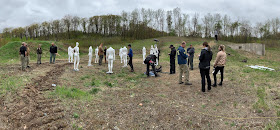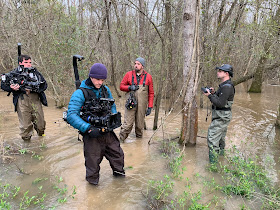Inside the small church at Corstorphine in Edinburgh, Scotland, lie the marble effigies of an important medieval married couple. Sir John Forrester (1380-1448), 2nd of Corstorphine, lies next to his second wife Jean Sinclair, the daughter of Earl Henry Sinclair. What makes these effigies so important is not just the individuals that prove the two clans obviously knew each other, but were literally aligned by blood. Consolidation of money and power through strategic marriages wasn't anything new then, or now, but this particular marriage was important for researchers trying to better understand the activities of these families and their connections to the Templar's after their put-down in 1307.
This very special blog post is a collaborative effort of myself, and my friend Steve St. Clair, in the week leading up to the final episode of season 4 of America Unearthed. The final episode is arguably the best in a season of 10 really good shows for it reveals exciting new evidence about the fugitive Templar's activities in North America circa 1400. During filming of the episode, I visited Rosslyn Chapel for the third time and really paid attention to the subtle carvings of mason's marks tucked among the labyrinth of incredible carvings throughout the building. On an east-west aligned beam in the east end of the church, I noticed a familiar, skillfully carved symbol between two ornately carved floral designs. It was the same hanging horn symbol found in the Forrester coat of arms so prominently featured in Corstorphine Church only a few miles north of Rosslyn, in Edinburgh.
The "fish" is an esoteric symbol of sacred geometry when two intersecting circles create three equidistant quadrants at the center. The middle quadrant is a vertical almond shape called the "Vesica Pisces". Roman Christians are familiar with the symbol when aligned horizontally as the Christian "fish" representing the ministry of the biblical Jesus. To Gnostic Christians initiated with certain esoteric knowledge, the symbol represents something else entirely in relation to Jesus and his First Century followers. The "fish" is one of the best examples of a symbol whose meaning is drastically different to people with opposing ideology allowing plausible deniability when challenged by both sides.
A bit of context is needed here to understand why this carving is so significant. Sir John Forrester, founded the extant church in 1429. His marriage to Jean Sinclair in the early part of the 15th Century establishes a few important facts. First, it is all but certain William Sinclair of Roslin (1410-1484) would have known Sir John Forrester as his aunt, Jean, was married to him. This also meant he would have been well aware of the Forrester coat of arms symbolism by the time ground was broken for the construction of Rosslyn Chapel, in 1446. At 36 years of age, William would have been well versed in his families' clan affiliations and politics of the time. Aside from the clan alliance through marriage, there would have been other affiliations such as through Freemasonry and the Scottish clan's rumored support of the Templars.
The chapel would have been at the foundation stage when Sir John Forrester died in 1448, and the beam with the Forrester "fish" was likely still at least a decade away from being installed. William must have had the Forrester hunting horn "fish" carving made as an ode to the clan his family was clearly aligned with. The fact the fish carving is positioned on its side, as Steve pointed out in our conversations, with the head "swimming" to the east, could be a symbolic reference to Jerusalem and knowledge of the Templars activities there in the previous two centuries. Whatever the meaning, the Forrester fish seems to be clear evidence of the strong alliance between these two powerful Scottish families in the late 14th and 15th Centuries at the very least.
Only a year before my discovery of the hanging horn symbol in Rosslyn, Steve found the effigies at Corstorphine during a trip to Scotland to conduct genealogical research. The Forrester Clan connection to the Sinclair Clan was important enough, but it was the "fish" symbol in the string of the hanging horn on the Forrester coat of arms that interested me. In my new book,
"Cryptic Code of the Templars in America: Origins of the Hooked X Symbol", I wrote about the 2000 year-long history of the fish symbol that runs from Jerusalem, to Scotland, and eventually to the United States hidden in plain sight for those with the eyes to see. I refer the reader to my blog of July 2nd of this year, and the picture of the letter written by General George Washington and the vertically aligned fish symbol above the "g" (God?) in his last name. Examples of Washington's signature show he began using the curious fish symbol
after he was raised as a Freemason at the age of 21.
It's time for Steve to chime in with his thoughts about the recent discovery of the Forrester fish at Rosslyn...
DNA SNPs and Medieval Records
Prove a Medieval Affinity Family
In 2018, I got a private tour of
Corstorphine and found exactly what I expected to find, the armorial bearings
of the Forrester family quartered with that of the Sinclair family of
Caithness.
Forrester Arms: Argent, three bugle horns Sable, garnished
Vert and stringed Gules.
Motto: Blaw, hunter, Blaw Thy Horn.
Sinclair Arms: Azune, a galley Or, the sail thereof Argent
Motto: Commit thy work to God.
No mention of a fish in any
records and I’ve never heard of anyone thinking this is a fish. You can tell
the carvings are recently painted and not exposed to the weather. Personally,
I’m not convinced the “bugle horns” are a vertical fish symbol, but I’m also no
expert on esoteric symbology. My area of focus is DNA and medieval land
transfer records.
My trip to Corstorphine was driven
by a DNA match that showed up quite by surprise in our advanced SNP
matches. About 4 years ago, a Forrester
gentleman showed up matching our Saint-Clairs of Herdmanston Ancestral lineage.
This wasn’t just any match - it was proved by Family Tree DNA’s Big Y test.
These tests pinpoint tens of thousands of parts of the human chromosome, so
they’re irrefutable matches. Better still, they’re backed up by Y-full dating of
the SNPs. And the dating is within a time frame that makes it terribly
interesting.
Here’s that last paragraph in
plain English:
In the definitive guide on our
family, researched and written by Rondo BB Me and Gerald Sinclair, we know
Henry II Sinclair of Rosslyn, 1st Earl of Orkney had a daughter, Jean Sinclair,
who married Sir John Forrester of Corstorphine (Enigmatic Sinclairs, p.65). In
yet another connection, William “The Waster” second Earl of Caithness, sold
land called Cardain Sinclair, and the Forrester's bought it. (Land tended to stay
“in the family.” If you know Rondo, you know her
research is irrefutable. That creates an interesting situation because the DNA
SNP match proves that the Herdmanston line of Sinclair, and Forrester's living
today, share male blood. That much is also irrefutable. Another way to say that is it’s a confluence of independently proven variables.
An important point to remember
about Corstorphine. When Cromwell invaded Scotland, he ran into a skirmish with,
among others, the Forrester family. Later, he took his revenge by destroying
much of Corstorphine Church, including the effigies. These were re-built in
1429, but some effigies were moved and re-carved. The thickness of the lines
holding the horns in that armorial bearing might have been carved to be thicker
at that point. Another important point to
remember, Adam Forrester (d. 1405) was a wealthy merchant in Edinburgh, not a
knight. He acquired Corstorphine from King Robert III and was appointed Keeper
of the Great Seal in 1390 as a reward for his services.
A word about armorial bearings
In the early medieval era, the use
of coats of arms had little structure. The first documented use of a coat of
arms was on the Bayeux Tapestry in the 11th century, and you can see they were
nowhere near as elaborate as they would become by the 14th century. Coats of arms were granted to
families by a ruling monarch. Use by country varied, but in Scotland and
England, they could only be used by aristocracy. By the 13th century, only the
person granted the coat of arms by a king could use it as it was granted. Successive generations had to change it slightly to distinguish it from
previous generations. The main way this was accomplished was by
"quartering." This practice is a great help to genealogists today
because successive families would add the symbol of families marrying into one
another. Thus, the Forrester shield in Corstorphine has the Sinclair armorial
quartered into it.
Scott’s discovery of what looks to
be the Forrester armorial hunting horn inside Rosslyn Chapel is potentially an
extremely interesting additional evidence of what we now know to be an incredibly
important affinity connection.
Sources - Ancestral Findings, "The Real
Truth Behind Coats of Arms and Family Crests"
https://ancestralfindings.com/real-truth-behind-coats-arms-family-crests/ Accessed
2 July, 2019.
“The Oxford Dictionary of Family
Names in Britain and Ireland,” edited by Patrick Hanks, Richard Coates, Peter
McClure https://bit.ly/2xj7yoJ Accessed 2 July, 2019.
Lewis, Samuel, "A
Topographical Dictionary of Scotland: Comprising the Several ..., Volume
1"
McAndrew, Bruce A.
"Scotland's Historic Heraldry", Boydell Press (March 20,
2014) ISBN-13: 978-1843832614.

The church in Corstorphine was originally founded on these grounds in 1128. Sir Adam Forrester added a burial chapel in 1404 and his son, Sir John Forrester 1st, founded the existing church in 1429.
In the burial chapel lie the effigies of Sir John Forrester and second wife, Jean Sinclair, the granddaughter of Earl Henry Sinclair. Five Coat of Arms carvings adorn the lower wall with the black engrailed cross of the Sinclair Clan (second from left, lower right quadrant).
The Coat of Arms of the Forrester Clan includes three hunting horns with wide strings in the shape of a vertically aligned fish symbol.
The Visica Pisces is the vertically aligned almond shape created when two intersecting circles are spaced creating three equidistant lengths at the center. When this shape is aligned horizontally it becomes the symbol familiar to Roman Christians related to the biblical Jesus.
The south side of Rosslyn Chapel is beautifully illuminated by the early morning sun on a clear January morning in 2019.
The Forrester "Fish" carving in Rosslyn is located on the south side of east-west running beam in the east end of the chapel.
Carved onto the south facing, east-west trending stone beam in the east end of the chapel is what appears to be mason's mark of the Forrester Clan hunting horn between two floral designs circled in red.
A close-up view reveals a skillfully carved hunting horn symbol of the Forrester Clan except it is aligned horizontally as opposed to vertical. To the right is what appears to be a Templar Cross in the middle of the design.
This north-south trending beam in the south aisle at Rosslyn Chapel have what have interpreted to aloe leaves. This plant was indigenous to North America and unknown in Europe in the 15th Century when Rosslyn was constructed. How did it get there?















































